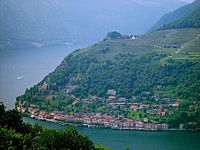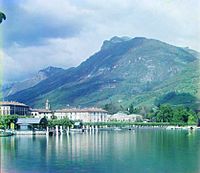Ticino facts for kids
Canton Ticino (also called Ticino) is the southernmost region, or canton, in Switzerland. It is special because it's the only canton where Italian is the main official language. Almost everyone here speaks Italian, except for one small town called Bosco Gurin, where people speak German.
Ticino is almost completely surrounded by Italy. It even wraps around a small Italian area called Campione d'Italia. Together with parts of another Swiss canton called Graubünden, Ticino forms what is known as Svizzera Italiana, or Italian Switzerland. The canton gets its name from the Ticino River, which flows through it.
Contents
Exploring Ticino's Geography
Ticino is located in the southern part of Switzerland. Most of its borders touch Italy to the east, west, and south. To the north, it borders other Swiss cantons like Valais and Uri. To the northeast, it borders Graubünden.
The canton covers an area of about 2,812 square kilometers (1,086 square miles). About three-quarters of this land is useful for farming or building. Forests cover about one-third of the area. Large lakes like Lake Maggiore and Lake Lugano also make up a big part of Ticino. These lakes are also known by their official names, Lake Verbano and Lake Ceresio.
Ticino is naturally divided into two parts by the Monte Ceneri pass. The northern part is more mountainous and is called Sopraceneri. This area includes two major valleys around Lake Maggiore: the Ticino Valley and the Maggia Valley. The southern part is called Sottoceneri and is the region around Lake Lugano.
The Ticino River is the longest river in the canton. It flows from the northwest through the Bedretto Valley and the Leventina valley. It then enters Lake Maggiore near Locarno. Its main smaller rivers are the Brenno and the Moesa. The river has shaped the land, creating a wide valley in its middle part, known as the Riviera.
The western parts of Ticino are drained by the Maggia River. The Verzasca Valley is located between the Ticino and Maggia rivers. A smaller area of land also drains directly into Lake Lugano. Most of Ticino is part of the Alps mountains. However, a small part of the canton is flat land, which is part of the Po River plain in northern Italy.
A Look at Ticino's History
Long ago, the area of Ticino was home to the Lepontii, a Celtic tribe. Later, it became part of the Roman Empire. After the Roman Empire fell, different groups ruled the land, including the Ostrogoths, the Lombards, and the Franks. Around the year 1100, the area was a battleground between the cities of Milan and Como. In the 1300s, the Visconti family, who were Dukes of Milan, took control.
In the 15th century, the Swiss Confederates (groups of Swiss regions) conquered the valleys south of the Alps in three separate stages. The Canton of Uri took the Leventina Valley in 1440. Later, Uri, Schwyz, and Nidwalden gained the town of Bellinzona and the Riviera in 1500. In 1512, troops from the entire Confederation (which had 12 cantons at that time) took Locarno, the Maggia Valley, Lugano, and Mendrisio.
The lands of Ticino were the last areas conquered by the Swiss Confederation. After a big battle in 1515, the Swiss stopped expanding. In 1798, people in Lugano fought off an attempt by another republic to take over their land. Between 1798 and 1803, the areas of Bellinzona and Lugano were separate cantons. But in 1803, they joined together to form the Canton of Ticino. It became a full member of the Swiss Confederation that same year.
Until 1878, the three largest cities—Bellinzona, Lugano, and Locarno—took turns being the capital of the canton. But in 1878, Bellinzona became the only and permanent capital. The current rules for how Ticino is governed were set in 1997.
How Ticino is Governed
Ticino has its own government, just like a small country. The cantonal parliament is called the Grand Council (Gran Consiglio in Italian). It has 90 members. The main government body is the Consiglio di Stato, which has 5 members. People vote for members of both councils using a system called proportional representation.
Ticino also sends representatives to the Swiss national government. It sends two members to the Swiss Council of States (the upper house) and eight members to the National Council (the lower house). The main city where the government meets is Bellinzona.
Ticino's Economy
The hilly areas of Ticino are great for making hydroelectricity. This is electricity made from the power of moving water. The electricity produced is used in Ticino and also sold to other places. In the northern parts of the canton, people raise cattle.
Making wine is also very important in Ticino. Most of the wine produced is merlot, a type of red wine. This wine is mainly sold to other parts of Switzerland. The best places for vineyards are in the warmer southern half of the canton. Other farm products include corn, potatoes, tobacco, and vegetables.
Ticino's weather is often different from the weather north of the Alps. It is generally warmer and sunnier. This warm climate and the beautiful lakes attract many tourists from other Swiss cantons. Tourism is the most important part of Ticino's economy.
There are also some light industries in Ticino. These are mostly found around the three biggest towns: Lugano, Locarno, and Bellinzona.
Ticino is well connected to the rest of Switzerland. There are tunnels through the Gotthard mountains for both trains and cars. You can also travel by train to major cities in Italy like Milan and Rome, and to Germany through Basel and Zürich.
Because so many tourists visit, there are several small railways in the scenic mountain areas. Winter sports are also popular, even though they are not as developed as in some other Swiss cantons.
Ticino also has two important centers for education and research. The University of Italian speaking Switzerland (USI) is the only Swiss university that teaches in Italian. The University of Applied Sciences of Italian speaking Switzerland (SUPSI) is a college that focuses on practical training in areas like art, business, social work, and technology.
Three daily newspapers are published in Ticino: Corriere del Ticino, La Regione, and Giornale del Popolo. These are the only daily newspapers in Italian published in Switzerland.
Language and Culture
The main language in Ticino is Italian. This is the language used for official documents and most written communication. However, when people talk, they often use local dialects of Western Lombard, which are called Ticinese. These dialects are still common, especially in the valleys. But in cities like Lugano, Ascona, and Locarno, and among younger people, Italian is becoming more common.
There are also local differences in these dialects. The dialects spoken in the northern valleys are more similar to Romansch, which is Switzerland's fourth official language. People in Ticino enjoy writing poems and comedies in Ticinese. The local radio and TV stations often broadcast programs in these dialects.
Religion in Ticino
Most people in Ticino are Roman Catholic, making up about 75% of the population. About 7% are Protestant. Smaller groups include Orthodox Christians and Muslims, each making up about 2% of the population.
Districts of Ticino
The Canton of Ticino is divided into 8 main areas called districts (distretti):
- Distretto di Mendrisio
- Distretto di Lugano
- Distretto di Locarno
- Distretto di Vallemaggia
- Distretto di Bellinzona
- Distretto di Riviera
- Distretto di Blenio
- Distretto di Leventina
Local Municipalities

Within these districts, there are many smaller areas called municipalities (comuni). As of 2006, there were 195 municipalities in Ticino. These municipalities are grouped into 38 circles (circoli), which are then part of the larger districts. Since the late 1990s, there has been a plan to combine some of the smaller municipalities to make them more efficient.
Aargau · Appenzell Innerrhoden · Appenzell Ausserrhoden · Basel-Stadt · Basel-Landschaft · Bern · Fribourg · Geneva · Glarus · Graubünden · Jura · Lucerne · Neuchâtel · Nidwalden · Obwalden · Schaffhausen · Schwyz · Solothurn · St. Gallen · Thurgau · Ticino · Uri · Valais · Vaud · Zug · Zürich
Images for kids
-
The small village of Brunescio in the Vallemaggia.
-
The Ursuline Palace in Bellinzona, where the government meets.
-
A view of Lugano, the largest city in Ticino, with Lake Lugano and Monte San Salvatore.
-
The Gotthard Base Tunnel, one of the longest railway tunnels in the world.
See also
 In Spanish: Cantón del Tesino para niños
In Spanish: Cantón del Tesino para niños











